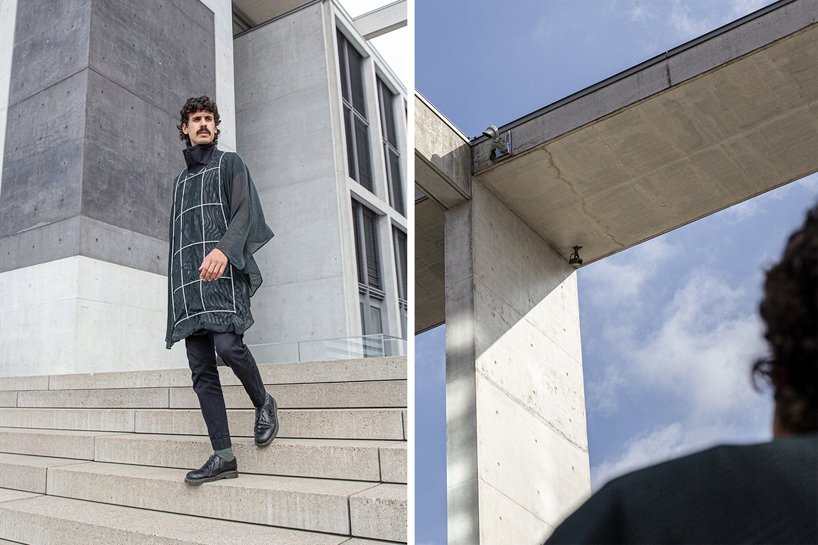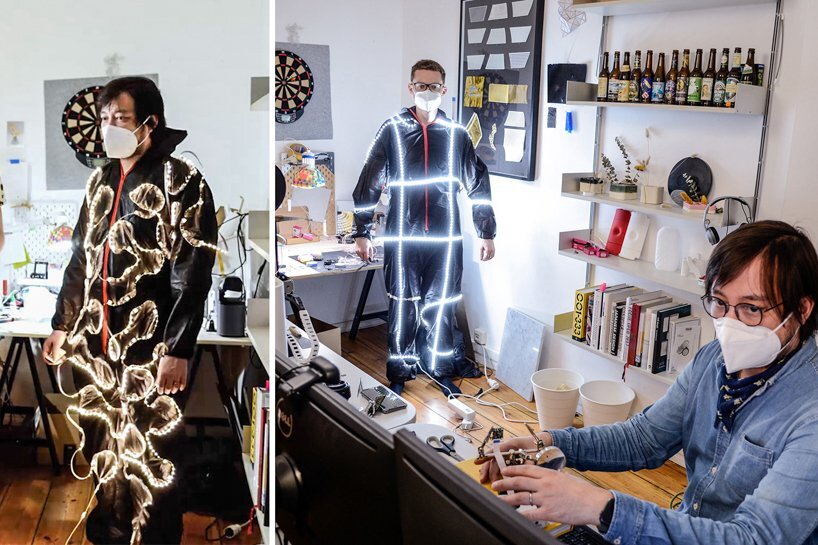werteloberfell develops an AI-fooling poncho to confuse CCTV algorithms
werteloberfell’s shield against AI
since it was first developed in the mid 20th century, CCTV (closed-circuit television) has become a ubiquitous sight in towns and cities across the globe. according to a report by industries researcher IHS markit in 2019, there are now 1 billion CCTV cameras in the world. however, these days modern CCTV doesn’t just record video footage, it also uses artificial intelligence with human detection and facial recognition algorithms to track our behavior and our emotions.
to protect people against this increased surveillance, german design studio werteloberfell has collaborated up with a team of technical partners to create apparel that messes with AI algorithms. the team’s first prototype takes shape as a glowing poncho called ‘ignotum’, which is latin for ‘the unknown’.

images courtesy of werteloberfell
THE DESIGN PROCESS
to create ignotum, the team had to first understand how CCTV with AI systems work. werteloberfell explains, ‘together with markus mau from studio moux, we determined that normally these systems work in a three-step process: to begin with, the AI filters out human beings from other objects in the scene by slicing the image in little tiles, analyzing contrast values within those, and then calculates the probability of recognition. it then applies a virtual skeleton to the found persons for better tracking of movement, after which high-quality facial images are sent to a server for deep analysis.’
after understanding how the AI works, they rigged up their own AI-enhanced camera system to find out which patterns would go undetected. eventually, the team found that a glowing grid pattern worked best to confuse the computer, indicating only ‘33% person’.

the final testing showed the poncho’s effectiveness in confusing the AI
THE FINAL PONCHO PROTOTYPE
the working prototype was realized mixing traditional tailoring, 3D printing and state-of-art electronics to textile bonding technologies. the final poncho integrates PCBs (printed circuit boards) and LEDs, which were created together with fraunhofer IZM. the final design utilizes light guides printed directly onto the textile of a poncho garment—a style chosen for its simplicity and versatility.
the poncho is composed of three layers. a base layer gives the whole garment its basic stability, a tech layer includes the printed circuit boards, the textile cable and the LEDs, all of which are covered by a moiré layer for an additional optical illusion effect.

the poncho is made up of three layers
A NEW KIND OF FASHION STATEMENT
‘ignotum is about confusing artificial intelligence (AI) that is used to analyse CCTV footage,’ says werteloberfell. ‘it is gaining personal information of filmed people like gender, age, emotional state and sexual preferences, some of them with very high accuracy. in recent years, these technologies have been finding their way into spaces of retail and are supposedly used for a better shopping experience. it can also be used for better sales by analyzing the emotional state of customers. we find this development questionable and with our project, the wearer gets to choose when to be visible to these technologies.’
not a commercial product, ignotum aims to raise awareness of AI-powered CCTV surveillance, and the agency technology can provide. the project was designed as part of the Re-FREAM consortium, a horizon 2020 project funded by the EU. Re-FREAM is about connecting people from different fields and backgrounds to work together in connecting fashion with technology. to create ignotum, werteloberfell worked together with technical partners from the fraunhofer IZM, stratasys, profactor and empa.

the layers are all interlaced with power cables, PCBs, LEDs and light fibers

the final design render
1/8
project info:
name: ignotum
project team:
werteloberfell: jan wertel, max krenn
fraunhofer IZM: christian dils, max marwede, robin hoske, lars stagun, dr. rafael jordan, kamil garbacz, sebastian hohner
stratasys: naomi kaempfer, yossi siso
empa: agnes psikuta
profactor: pavel kulha
wear it: ioana puscasu, manon montant
other collaborators: markus mau, mira thul-thellmann, tim schütze
designboom has received this project from our DIY submissions feature, where we welcome our readers to submit their own work for publication. see more project submissions from our readers here.
edited by: lynne myers | designboom










